





Published on Feb 14, 2025
For every leaving specie communication is a way by which they share/pass their thoughts/fillings to one another. We homosepians mainly use verbal communication to communicate with each other. In this Paper we introduce VSP, a Virtual Smart Phone which is basically a step to connect both the Physical and virtual world, by using a tiny projector, Camera, Speaker, mike & Cloud Computing Technology over the internet in the form of wearable device. In VSP all the required component are fabricated in the wearable device by which use communicate with the help of natural hand gesture, Hand movement and Internet. In VSP user communicate with each other by Virtual mobile phone with the help of touch gesture radio wave and cloud computing technology.
VSP will end the physical dependency of mobile phone. VSP provide novel interaction method to seamlessly communicate with each other in a fun and intuitive way. The user can touch their Palm to make call and can also be used for watching movies or Images on their Palm/wrist. Touch gesture is used for making and Terminating the call. VSP uses touch-based interactions as instruction for establishing communication between the different users.
The recent advent of novel sensing and display technologies has encouraged the development of a variety of multi-touch and gesture based interactive systems. In these systems user may interact directly with information using touch add natural hand gestures. Today there are lots of way by which we can connect to digital world in the controlled environment using muti-touch and gesture based interaction. Unfortunately, most gestural and multi-touch based interactive systems are not mobile and small mobile devices fail to provide the intuitive experience of full-sized gestural systems.
Moreover, information still resides on screens or dedicated projection surfaces. There is no link between our interaction with these digital devices and interaction with the physical world around us. In this paper, we present VSP-Virtual Smart Phone, a multi-touch and gesture based interaction system. Which replace the physical mobile phone device to the virtual multi-touch & natural gesture based interaction on the user palm by which user communicate with other digital devices over the network. VSP basically turns the human hand as a mobile phone by which is able to user connect to the digital world as well as other peoples like their friends and relatives.
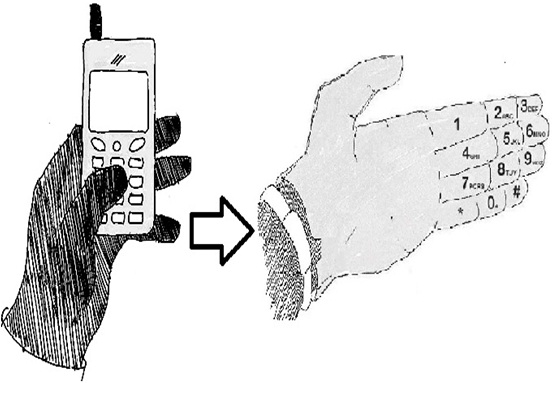
VSP is basically a computer-vision based wearable and gestural information interface that augments the physical world around us with digital information and proposes natural hand gestures as the mechanism to interact with that information.
Recently, there have been a great variety of multi-touch interaction and mobile device products or research prototypes that have made it possible to directly manipulate user interface components using touch and natural hand gestures. Most of these systems depend on the physical touch-based interaction between the user’s fingers and physical screen and thus do not recognize and incorporate touch independent freehand gestures. VSP Virtual Smart Phone Technology takes a different approach to computing and tries to make the digital aspect of our lives more intuitive, interactive and, above all, more natural. It’s a lot of complex technology squeezed into a simple portable device. When we bring in connectivity, we can get instant, relevant visual information projected on any object we pick up or interact with the technology is mainly based on hand augmented reality, gesture recognition, computer vision based algorithm etc.
Augmented reality (AR) is a term for a live direct or indirect view of a physical real world environment whose elements are augmented by virtual computer-generated imagery. It is related to a more general concept called mediated reality in which a view of reality is modified (possibly even diminished rather than augmented) by a computer. The augmentation is conventionally in real-time and in semantic context with environmental elements.
Virtual Smart Phone uses Augmented Reality concept to superimpose digital information on the physical world. With the help of advanced AR technology (e.g. adding computer vision and object recognition) the information about the surrounding real world of the user becomes interactive and digitally usable. Artificial information about the environment and the objects in it can be stored and retrieved as an information layer on top of the real world view. The main hardware components for augmented reality are: display, tracking, input devices, and computer. Combination of powerful CPU, camera, accelerometers, GPS and solid state compass are often present in modern Smartphone, which make them prospective platforms.
Gesture recognition is a topic in computer science and language technology with the goal of interpreting human gestures via mathematical algorithms. Gestures can originate from any bodily motion or state but commonly originate from the face or hand. Current focuses in the field include emotion recognition from the face and hand gesture recognition. Many approaches have been made using cameras and computer vision algorithms to interpret sign language. Gesture recognition can be seen as a way for computers to begin to understand human body language, thus building a richer bridge between machines and humans than primitive text user interfaces or even GUIs (graphical user interfaces), which still limit the majority of input to keyboard and mouse. Gesture recognition enables humans to interface with the machine (HMI) and interact naturally without any mechanical devices. Gestures can be used to communicate with a computer so we will be mostly concerned with empty handed semiotic gestures.
Computer vision is the science and technology of machines that can see. As a scientific discipline, computer vision is concerned with the theory behind artificial systems that extract information from images. The image data can take many forms, such as video sequences, views from multiple cameras, or multi-dimensional data from a medical scanner. The software tracks the user’s gestures using computervision based algorithms. The computer vision system for tracking and recognizing the hand postures that control the menus is based on a combination of multi-scale color feature detection, view based hierarchical hand models and particle filtering. The hand postures or states are represented in terms of hierarchies of multi-scale color image features at different scales, with qualitative interrelations in terms of scale, position and orientation. In each image, detection of multistage color features is performed.
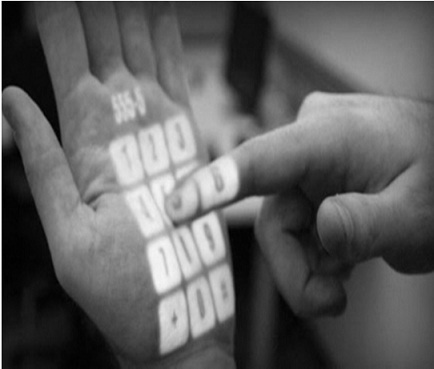
The hand postures are then simultaneously detected and tracked using particle filtering, with an extension of layered sampling referred to as hierarchical layered sampling. To improve the performance of the system, a prior on skin color is included in the particle filtering. Figure 2: Gesture Recognized Mobile Keypad VSP is also related to augmented reality where digital information is superimposed on the user’s view of a scene but it also differ in several significant ways. First VSP allows user to interact with the projected information using hand gestures. Second the information is projected onto the Hand/object and surfaces themselves, rather than onto glasses, goggles or watch which results in a very different user experience.
VSP Invention is related to transfer of Data & establishing communication from one human body to other human body or from one human body to digital devices or vice-versa without any platform dependency. VSP is basically an attempts to make the communication between users and Digital devices more tangible and interactive. The objective of this invention is establishing the connection/communication between humans and also with digital devices by a touch gesture on the human Palm/Hand. VSP work on two type of data transfer.
First, It establish voice communication between the users with the help of GSM Technology without any physical cellular phone.
Second, For Transfer of Data between the humans and also with digital devices. It make use of the Internet, Intranet network or any other type of data Servers through which device and humans are connected to and the distinguish from one user to another by the authentication methods such as username/password, drawing a pattern on the virtual screen, face recognition, Palm recognition using palm lines or fingerprint detection can be used. In VSP voice communication form one human to another can be done either by using GSM or Internet/Intranet technology.
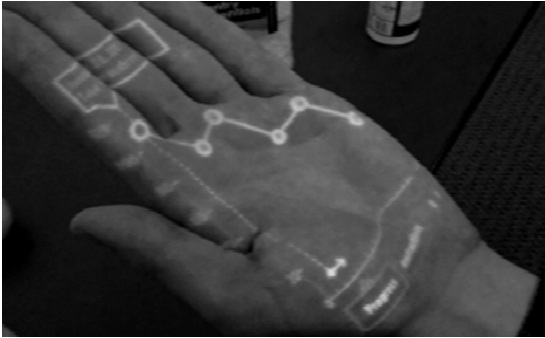
The Transferring of data from one human being to another or device using VSP. The first and second digital devices may be gesture recognition VSP system connected to a network including a data storage cloud and both uses VSP Technology.
Working of VSP consist of 5 Main steps i.e. Enabling & Authenticate VSP, Make Call, Receive Call, Capture Image/Video, Copying Data & paste/Pass Data to other VSP & Digital Devices as follows.
The VSP is a wearable device and user has the key to Enable (ON)/Disable (OFF) the device through the Power Button. When user enable the VSP Device, an icon appears on the user palm or arm as per user as per selected by the user for showing the status (if a user has signed in).If not user can touch this icon to login or change users using different authentication methods like: Enter user name and password, Drawing a secret sign or pattern, Face recognition, Picture selection and Fingerprint detection and Palm line Detection after a user has signed in successfully, VSP is now Ready for making and receive calls and other Operations.
After Enabling VSP now user is able to make call and communicate with their relatives and other persons. To make call, Dial mobile number using virtual key or using Voice Recognition system. For establishing call between two users, VSP uses two method that are as follows.
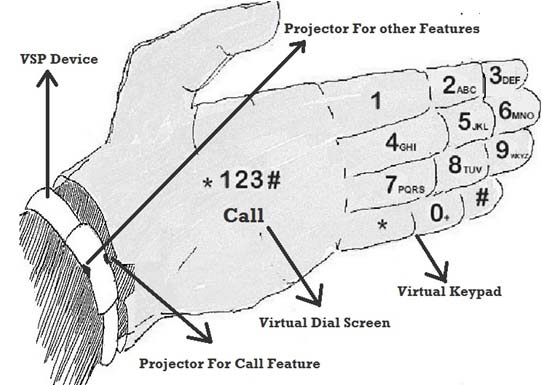
a. Make Call Using SIM:
VSP device has a micro SIM (Subscriber Identity Module) by which device established the call using GSM/CDMA (Global System for Mobile Communications / Code Division Multiple Access) Technology.
b. Make Call Using VOIP:
VSP device has a Wi-Fi (Wireless Fidelity) and Mobile Data option which connect the device to the Intranet/Internet, by using this user is able to make calls using VOIP (Voice Over IP) Technology. By using VOIP user is able to make the call to other VSP user as well as all the others GSM and Internet VOIP enable Digital Devices. When user is not connected to internet/Intranet, call is simply made using SIM without user’s permission but when user connect to Internet it ask user to select the option by which user wanted to make call as per user selection the call is connect to other person.
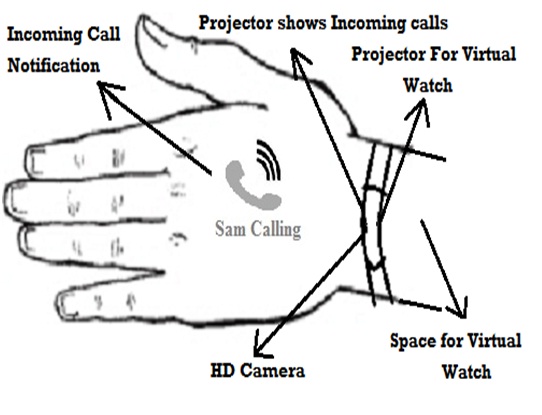
When a VSP user called by other VSP user or other digital device users by (Physical Mobile phone laptop, Desktop and PDA ‘Personal Data assistant) the notification of incoming call will be shown as per user selected Profile if user select vibrate mode, the small vibrator motor indicate incoming call by vibration & also shows the identity of calling user on back side of palm using high Density projector of VSP. If user select Sound Mode, incoming call notified by selected ring tone with user Name on the back side of Palm. In Silent mode it only indicate the name of caller in the back side of palm. For attending the incoming call user just touch, swipe the incoming call icon or other touch gesture selected by user. To speak the caller user either use Bluetooth Headset or wired headset which is connected to VSP device using 3.0 connector. User also is able to receive call directly using VSP Device Speaker and Mice. For VOIP calls both user must be connected to the internet using WI-FI or Mobile Data.
VSP is also able to capture high Quality Images/Video using their high Quality Camera by click capture image button or by using gesture (make a fame using our index figure and thumbs) for taking photos. After taking the picture it shows the picture on user hand using VSP System. For shoot video with the same gesture user just required to change the camera mode photos to video. User also zoom in or zoom out while they capture Image/Video using their hand gesture.
In VSP allow users to Transfer (Copy/Paste) Data from one human body to another human body or device by using a single touch gesture. For copy data user has to login First in VSP device and connected to Internet/Intranet. For identifying a copy event in VSP uses a long press (Detect by listener Program) on copy able data item (keeping finger on a data item more than 1.5 sec. shown on user arm using VSP projector) indicates to copy that data item. Whenever user Touch any copy able data a touch listener program start counting the time and when time exceeds the threshold (1.5 sec.) a message appears indicating that the data item is being copied and gets copied to the user’s unique space in the data cloud. The copy Data to the data cloud can also be done by alternative ways (instead of long-press for 1.5 seconds). For example, double tap on data item or draw a circle around the data item to initiate copy. Using this process user copy multiple file for passing/paste to the other device all the copy data save in the cloud on temporary bases with unique id of each data item.
VSP is basically a wearable device which is combination of hardware as well as software. In hardware VSP consist of Processor Unit, Ram & Rom Memory, Power supply (battery), Sensors (Accelerometer, 16 Proximity sensor for identifying touch on Arm), LED Indicator For Device Mode (ON/OFF), Micro Vibrator Motor, USB port (For charging or attaching other devices), 4 micro Projectors (like Pico Projectors), 1 HD Camera for Capturing Images and videos, Low energy Required WI-FI and Bluetooth devices, GPS system, 4 touch buttons (ON/OFF Button, Snap Button, sound Up button, sound down button) and Nano SIM card slot. In software it use gesture recognition system, Touch based interaction system, Augmented Reality, computer vision based algorithm to fulfill all the objectives.
VSP uses the following Technology for Make Call, Receive Call, Copying Data & paste/Pass Data to other VSP & Digital Devices.
In VSP voice call done by using either by using SIM (GSM/CDMA) or though Internet using VOIP Technology.
Data transfer from one body to another body or device in using VSP is done by using Data Cloud. For Accessing Data cloud user may be connected to Internet either by WI-FI or Mobile Data using SIM.
VSP is basically a computer-vision based wearable and gestural interface that augments the physical world around us with digital information and proposes natural hand gestures as the mechanism to interact with that information. It connect Physical world to Virtual world. VSP give intuitive way to communicate and Data Transfer between different users as well as different Digital Devices.
VSP invention fulfill our two future requirements. First, it’s free form physical dependencies of devices. Second, it connect our physical world to virtual world Some Application of VSP as Follows:
1. Used In Health Monitoring System.
2. Used to Find Information of any Product/Item.
3. Used to Connect News and Weather Update.
4. Used to connect Different Devices Virtually.
5. Used in Education & Training system.
[1] P. Mistry, Liyan Chang, P. Maes. “wuw - wear your world - a wearable gestural interface” Boston, United ACM 978-1-60558-246- 7/09/04.
[2] Happy, Pragti, Dr. Niranjan Bhattacharyya, ”Sparsh (Touch The Cloud) ” International Journal of Emerging Technology and Advanced Engineering (IJETAE), ISSN 2250-2459, ISO 9001:2008 Certified Journal, Volume 5, Issue 3, March 2014.
[3] Mikael Goldstein, Didier Chincholle “the finger-joint gesture wearable keypad” Stockholm, Sweden Research, SE-164 80.
[4] Mathias Kolsch, Matthew Turk “keyboards without keyboards: a survey of virtual keyboards” Dept. of Computer Science University of California at Santa Barbara, CA.
| Are you interested in this topic.Then mail to us immediately to get the full report.
email :- contactv2@gmail.com |